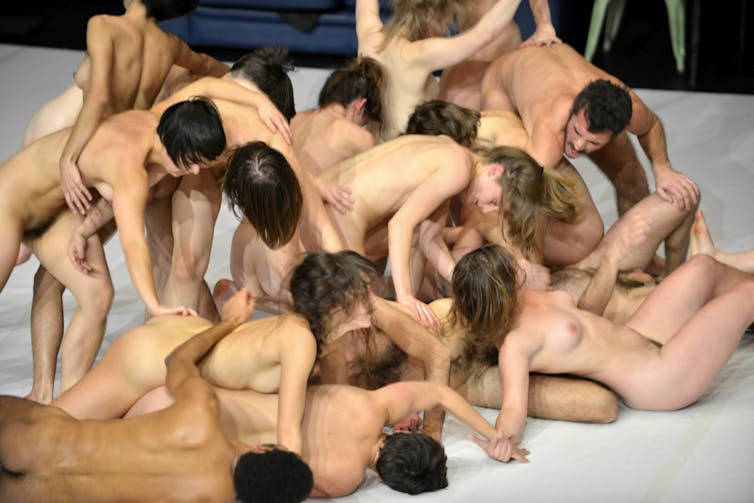The promotional copy for Mette Ingvartsen’s 7 Pleasures, playing at the Arts Centre as part of the Melbourne Festival, claims the performance is “upending clichés about nudity”. But what are these cliches? Those which spring most readily to my mind centre around the “confrontational” use of nudity in contemporary dance and performance art.
These cliches are, perhaps, a function of time, as the performance art of the 60s and 70s is now so institutionalised it feels passé. How then, might one create contemporary performance with naked bodies that avoids revising the work of those (from Marina Abramović to Xavier Le Roi) who have come before?
7 Pleasures contributes by exploring the sensual and sexual connections between human and non-human, between subjects and objects. It does so through a series of sustained movements for 12 dancers, that riff on certain modes of sensual engagement.
7 Pleasures opens by separating the bodies of the performers from the collective body of the audience. Planted amongst us, they stand, undress and make their way on-stage. Their bodies fuse together, a draped assortment of bare parts; almost (but not quite) homogeneous. In silence, this organism swarms with slow, deliberate, fluidity across the floor: like ants, they formicate over a couch, around a table, arriving at last at the front of the stage, where they find one last remaining body and draw it into the fold.
This opening introduces the audience to the glacial pace of the work, and a modality more compositional than choreographic; a series of subtle tone paintings for flesh.
One could approach this work in terms of experience and sensation. However, there is strong cerebral organisation and structure to it. I was drawn to a particular sequence through the movements (or sections) in the work, as they offer one useful point of entry into what is otherwise a difficult piece to discuss.

After the introduction, the dancers disperse, and begin to engage with the objects that populate the sparse set. A pelvis rubs sensuously against the corner of a coffee table. A shag rug is caressed. An indoor potted Yukka plant is nuzzled. These objects become objects of desire. Then, the scene suddenly shifts: a new rhythm emerges, created by the frenetic flapping of male genitalia. It spreads like a virus; the whole troupe begins to shake, pulse, flap and quiver.
The bodies draw together to become a locomotive orgy of touching, joining and rubbing that steams around the stage. It descends upon the potted Yukka; which also begins to shake and quiver. Then the couch. With increasing frenzy, cushions are scattered, furniture is thrown around, things are unravelled. The endurance of the dancers is remarkable, as their wild, pulsing bodies go on and on, the soundtrack of drums driving faster and faster. Finally, this section of the work crashes like a wave, leaving us with darkness and silence.
The next section of the work keeps us in the shadows, shifting mood entirely. The bodies again engage in sensual acts with objects, but here the objects serve to mediate human-to-human sensuality. Bowls, ropes, straps, pipes, strips of paper and metallic balls all pass between people as conduits for sensation.
These scenes raise a series of questions which have, in recent years, emerged as a new branch of inquiry within (or better, from) the humanities. This includes a new consideration of the agency and experience of things we categorise as “non-human”, including animals and objects. For this reason, the turn has been understood broadly by the term “post-humanities”.
As I watched the Yukka and the couch get roughed up, it seemed to me a violation. But how could I know? How much do we, as humans, impose our own schema of sense and experience on things? How would we ask a non-human thing for consent? The second and final section seems to answer this clearly. We don’t. We use these things selfishly, we enlist them into our battles.
The anthropocentric nature of relations between humans and non-humans becomes most explicit in the fourth and final section, where the bodies are divided into clothed and unclothed, and the performers build up a primal, rhythmic grunting and chanting. They come together, unified and facing us in what appears to be worship, with one of the dancers venturing to climb out into the audience. In this gesture of togetherness, the post-human concerns are replaced with an encompassing “pre-humanism” that erases difference though anthropological cliché, and shares an uncomfortable proximity to the logic of the Paleo diet.
It is the human body that 7 Pleasures ultimately revolves around. However, to explore body politics with a troupe of muscular, lean, able bodied dancers, with only Ligia Lewis breaking the homogeneous whiteness, limits the kinds of questions one might ask. In comparison to recent contributions such as Claire Cunningham’s Give Me A Reason to Live (2015), and Force Majeure’s Nothing to Lose (2015), 7 Pleasures struggles to confront.
7 Pleasures is at the Arts Centre Melbourne until October 22.

